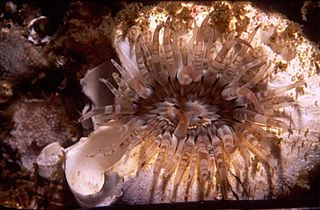
Eunicella verrucosa, the broad sea fan, pink sea fan or warty gorgonian, is a species of colonial Gorgonian "soft coral" in the family Gorgoniidae. It is native to the north-eastern Atlantic Ocean and the western Mediterranean Sea.

Jasus lalandii, the Cape rock lobster or West Coast rock lobster, is a species of spiny lobster found off the coast of Southern Africa. It is not known whom the specific epithet lalandii commemorates, although it may the French naturalist and taxonomer Pierre Antoine Delalande.

Duvaucelia odhneri, is a species of dendronotid nudibranch. It is a marine gastropod mollusc in the family Tritoniidae.

Corynactis annulata, or the strawberry anemone, is a bright pink colonial anthozoan similar in body form to sea anemones and scleractinian stony corals. This species is a solitary animal of the order Corallimorpharia.

The walking anemone, also known as the hedgehog anemone or sock anemone, is a species of sea anemones in the order Actiniaria. It is the only member of its genus, Preactis.

The multicoloured sea fan is a species of gorgonian sea fan in the family Melithaeidae.

The ring-tentacle anemone is a species of sea anemone in the family Isanthidae.

The Cape zoanthid is a species of zoanthid in the family Parazoanthidae.

The purple soft coral is a species of colonial soft coral in the family Alcyoniidae.

The cauliflower soft coral is a species of colonial soft coral in the family Nephtheidae.

The feathery sea pen is a species of sea pen in the family Virgulariidae.

The gorgonian twig coral is a species of gorgonian sea fan in the family Anthothelidae.

The whip fan, also called the flagellar sea fan, is a species of gorgonian sea fan in the family Eunicellidae.

The nippled sea fanEunicella microthela previously known by the junior synonym Eunicella papillosa, is a species of gorgonian sea fan in the family Gorgoniidae.

The palmate sea fan is a species of gorgonian sea fan in the family Gorgoniidae.
Swiftia pallida is a species of gorgonian-type octocoral in the family Plexauridae sometimes known as the northern sea fan. At one time it was considered to be a subspecies of Swiftia rosea.

Astrocladus euryale, the basket star, or gorgon's head is a brittlestar of the family Gorgonocephalidae found in the coastal waters of South Africa from the west coast of the Cape Peninsula to about Algoa Bay.
The Betty's Bay Marine Protected Area is part of the Kogelberg Biosphere Reserve. It is about 29km south-east of Gordon's Bay and approximately 37km north-west of Hermanus on the south-western coast of the Western Cape. It is in the Atlantic Ocean immediately adjacent to the town of Betty's Bay, in the Overstrand Municipal area.

The De Hoop Marine Protected Area lies between Arniston and the mouth of the Breede River on the south coast of South Africa adjacent to the De Hoop Nature Reserve. The MPA is 51 kilometres long, and extends 5 nautical miles to sea. The whole MPA is a restricted area and is part of the migratory route and calving area for Southern right whales. The area protects habitats for several economically important inshore reef fish species, and ensures the retention of marine biomass in this part of the coast. The limestone coastline is includes archaeological sites and middens that date back centuries. The MPA is close to the Breede River estuary and, provides protection for species like cob that breed in the estuary and then return to the ocean.
The Cape Canyon Marine Protected Area is an offshore marine protected area on the continental shelf edge lying approximately 10 nautical miles west of Paternoster off the Western Cape in the exclusive economic zone of South Africa.


















